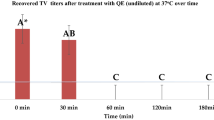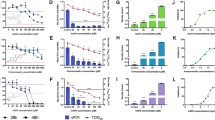Abstract
Human noroviruses (HuNoVs) cause foodborne and waterborne viral gastroenteritis worldwide. Because HuNoV culture systems have not been developed thus far, no available medicines or vaccines preventing infection with HuNoVs exist. Some herbal extracts were considered as phytomedicines because of their bioactive components. In this study, the inhibitory effects of 29 edible herbal extracts against the norovirus surrogates murine norovirus (MNV) and feline calicivirus (FCV) were examined. FCV was significantly inhibited to 86.89 ± 2.01 and 48.71 ± 7.38% by 100 μg/mL of Camellia sinensis and Ficus carica, respectively. Similarly, ribavirin at a concentration of 100 μM significantly reduced the titer of FCV by 77.69 ± 10.40%. Pleuropterus multiflorus (20 μg/mL) showed antiviral activity of 53.33 ± 5.77, and 50.00 ± 16.67% inhibition was observed after treatment with 20 μg/mL of Alnus japonica. MNV was inhibited with ribavirin by 59.22 ± 16.28% at a concentration of 100 μM. Interestingly, MNV was significantly inhibited with 150 µg/mL Inonotus obliquus and 50 μg/mL Crataegus pinnatifida by 91.67 ± 5.05 and 57.66 ± 3.36%, respectively. Treatment with 20 µg/mL Coriandrum sativum slightly reduced MNV by 45.24 ± 4.12%. The seven herbal extracts of C. sinensis, F. carica, P. multiflorus, A. japonica, I. obliquus, C. pinnatifida, and C. sativum may have the potential to control noroviruses without cytotoxicity.
Similar content being viewed by others
References
Adianti, M., Aoki, C., Komoto, M., Deng, L., Shoji, I., Wahyuni, T. S., et al. (2014). Anti-hepatitis C virus compounds obtained from Glycyrrhiza uralensis and other Glycyrrhiza species. Microbiology and Immunology, 58(3), 180–187.
Alfajaro, M. M., Kim, H., Park, J., Ryu, E., Kim, J., Jeong, Y., et al. (2012). Anti-rotaviral effects of Glycyrrhiza uralensis extract in piglets with rotavirus diarrhea. Virology Journal, 9(1), 310.
Arthur, S. E., & Gibson, K. E. (2015). Physicochemical stability profile of Tulane virus: a human norovirus surrogate. Journal of Applied Microbiology, 119(3), 868–875.
Asres, K., Bucar, F., Kartnig, T., Witvrouw, M., Pannecouque, C., & De Clercq, E. (2001). Antiviral activity against human immunodeficiency virus type 1 (HIV-1) and type 2 (HIV-2) of ethnobotanically selected Ethiopian medicinal plants. Phytotherapy Research, 15(1), 62–69.
Atta, A., & Alkofahi, A. (1998). Anti-nociceptive and anti-inflammatory effects of some Jordanian medicinal plant extracts. Journal of Ethnopharmacology, 60(2), 117–124.
Behbahani, M. (2014). Anti-HIV-1 activity of eight monofloral Iranian honey types. PLoS ONE, 9(10), e108195.
Bent, S., & Ko, R. (2004). Commonly used herbal medicines in the United States: a review. The American Journal of Medicine, 116(7), 478–485.
Cai, Y., Luo, Q., Sun, M., & Corke, H. (2004). Antioxidant activity and phenolic compounds of 112 traditional Chinese medicinal plants associated with anticancer. Life Sciences, 74(17), 2157–2184.
Chang, K. O., & George, D. W. (2007). Interferons and ribavirin effectively inhibit Norwalk virus replication in replicon-bearing cells. Journal of Virology, 81(22), 12111–12118.
Collins, R. A., & Ng, T. B. (1997). Polysaccharopeptide from Coriolus versicolor has potential for use against human immunodeficiency virus type 1 infection. Life Sciences, 60(25), PL383–PL387.
Dao, T. T., Nguyen, P. H., Won, H. K., Kim, E. H., Park, J., Won, B. Y., et al. (2012). Curcuminoids from Curcuma longa and their inhibitory activities on influenza A neuraminidases. Food Chemistry, 134(1), 21–28.
Ding, P., Liao, Z., Huang, H., Zhou, P., & Chen, D. (2006). (+)-12α-Hydroxysophocarpine, a new quinolizidine alkaloid and related anti-HBV alkaloids from Sophora flavescens. Bioorganic & Medicinal Chemistry Letters, 16(5), 1231–1235.
Dong, C., Hayashi, K., Lee, J., & Hayashi, T. (2010). Characterization of structures and antiviral effects of polysaccharides from Portulaca oleracea L. Chemical & Pharmaceutical Bulletin, 58(4), 507–510.
Dorman, H., & Deans, S. (2000). Antimicrobial agents from plants: antibacterial activity of plant volatile oils. Journal of Applied Microbiology, 88(2), 308–316.
D’Souza, D. H. (2014). Phytocompounds for the control of human enteric viruses. Current Opinion in Virology, 4, 44–49.
Efferth, T., Marschall, M., Wang, X., Huong, S., Hauber, I., Olbrich, A., et al. (2002). Antiviral activity of artesunate towards wild-type, recombinant, and ganciclovir-resistant human cytomegaloviruses. Journal of Molecular Medicine, 80(4), 233–242.
Eo, S., Kim, Y., Lee, C., & Han, S. (1999). Antiviral activities of various water and methanol soluble substances isolated from Ganoderma lucidum. Journal of Ethnopharmacology, 68(1), 129–136.
Green, J., Vinje, J., Gallimore, C. I., Koopmans, M., Hale, A., & Brown, D. W. (2000). Capsid protein diversity among Norwalk-like viruses. Virus Genes, 20(3), 227–236.
Haruyama, T., & Nagata, K. (2013). Anti-influenza virus activity of Ginkgo biloba leaf extracts. Journal of Natural Medicines, 67(3), 636–642.
Jassim, S., & Naji, M. A. (2003). Novel antiviral agents: a medicinal plant perspective. Journal of Applied Microbiology, 95(3), 412–427.
Jones, M. K., Grau, K. R., Costantini, V., Kolawole, A. O., de Graaf, M., Freiden, P., et al. (2015). Human norovirus culture in B cells. Nature Protocols, 10(12), 1939–1947.
Lazreg Aref, H., Gaaliche, B., Fekih, A., Mars, M., Aouni, M., Pierre Chaumon, J., et al. (2011). In vitro cytotoxic and antiviral activities of Ficus carica latex extracts. Natural Product Research, 25(3), 310–319.
Lee, M. H., Lee, B., Jung, J., Cheon, D., Kim, K., & Choi, C. (2011). Antiviral effect of Korean red ginseng extract and ginsenosides on murine norovirus and feline calicivirus as surrogates for human norovirus. Journal of Ginseng Research, 35(4), 429.
Lee, J., Miyake, S., Umetsu, R., Hayashi, K., Chijimatsu, T., & Hayashi, T. (2012). Anti-influenza A virus effects of fructan from Welsh onion (Allium fistulosum L.). Food Chemistry, 134(4), 2164–2168.
Lee, M. H., Seo, D. J., Kang, J., Oh, S. H., & Choi, C. (2014). Expression of antiviral cytokines in Crandell-Reese feline kidney cells pretreated with Korean red ginseng extract or ginsenosides. Food and Chemical Toxicology, 70, 19–25.
Li, D., Baert, L., & Uyttendaele, M. (2013). Inactivation of food-borne viruses using natural biochemical substances. Food Microbiology, 35(1), 1–9.
Lin, T., Wang, K., Lin, C., Chiang, L., & Chang, J. (2013). Anti-viral activity of water extract of Paeonia lactiflora pallas against human respiratory syncytial virus in human respiratory tract cell lines. The American Journal of Chinese Medicine, 41(3), 585–599.
Liu, H., Qiu, N., Ding, H., & Yao, R. (2008). Polyphenols contents and antioxidant capacity of 68 Chinese herbals suitable for medical or food uses. Food Research International, 41(4), 363–370.
Lv, L., Sun, Y. R., Xu, W., Liu, S. W., Rao, J. J., & Wu, S. G. (2008). Isolation and characterization of the anti-HIV active component from Eucommia ulmoides. Journal of Chinese Medicinal Materials, 31(6), 847–850.
Min, B. S., Jung, H. J., Lee, J. S., Kim, Y. H., Bok, S. H., Ma, C. M., et al. (1999). Inhibitory effect of triterpenes from Crataegus pinatifida on HIV-I protease. Planta Medica, 65(4), 374–375.
Nakane, H., & Ono, K. (1990). Differential inhibitory effects of some catechin derivatives on the activities of human immunodeficiency virus reverse transcriptase and cellular deoxyribonucleic and ribonucleic acid polymerases. Biochemistry, 29(11), 2841–2845.
Negi, P. S. (2012). Plant extracts for the control of bacterial growth: Efficacy, stability and safety issues for food application. International Journal of Food Microbiology, 156(1), 7–17.
Ohta, Y., Lee, J., Hayashi, K., Fujita, A., Park, D. K., & Hayashi, T. (2007). In vivo anti-influenza virus activity of an immunomodulatory acidic polysaccharide isolated from Cordyceps militaris grown on germinated soybeans. Journal of Agricultural and Food Chemistry, 55(25), 10194–10199.
Orhan, D. D., Orhan, N., Ozcelik, B., & Ergun, F. (2009). Biological activities of Vitis vinifera L. leaves. Turkish Journal of Biology, 33, 341–348.
Patel, D., Kumar, R., Laloo, D., & Hemalatha, S. (2012). Diabetes mellitus: an overview on its pharmacological aspects and reported medicinal plants having antidiabetic activity. Asian Pacific Journal of Tropical Biomedicine, 2(5), 411–420.
Payet, B., Shum Cheong Sing, A., & Smadja, J. (2005). Assessment of antioxidant activity of cane brown sugars by ABTS and DPPH radical scavenging assays: determination of their polyphenolic and volatile constituents. Journal of Agricultural and Food Chemistry, 53(26), 10074–10079.
Perumalla, A., & Hettiarachchy, N. S. (2011). Green tea and grape seed extracts-potential applications in food safety and quality. Food Research International, 44(4), 827–839.
Piacente, S., Pizza, C., De Tommasi, N., & Mahmood, N. (1996). Constituents of Ardisia japonica and their in vitro anti-HIV activity. Journal of Natural Products, 59(6), 565–569.
Re, R., Pellegrini, N., Proteggente, A., Pannala, A., Yang, M., & Rice-Evans, C. (1999). Antioxidant activity applying an improved ABTS radical cation decolorization assay. Free Radical Biology and Medicine, 26(9), 1231–1237.
Sánchez, C., Aznar, R., & Sánchez, G. (2015). The effect of carvacrol on enteric viruses. International Journal of Food Microbiology, 192, 72–76.
Sarkar, S., Koga, J., Whitley, R. J., & Chatterjee, S. (1993). Antiviral effect of the extract of culture medium of Lentinus edodes mycelia on the replication of herpes simplex virus type 1. Antiviral Research, 20(4), 293–303.
Shibnev, V., Mishin, D., Garaev, T., Finogenova, N., Botikov, A., & Deryabin, P. (2011). Antiviral activity of Inonotus obliquus fungus extract towards infection caused by hepatitis C virus in cell cultures. Bulletin of Experimental Biology and Medicine, 151(5), 612–614.
Shin, W., Lee, K., Park, M., & Seong, B. (2010). Broad-spectrum antiviral effect of Agrimonia pilosa extract on influenza viruses. Microbiology and Immunology, 54(1), 11–19.
Singh, A. (2011). Herbalism, phytochemistry and ethnopharmacology. Boca Raton: CRC Press.
Song, J., Park, K., Shim, A., Kwon, B., Ahn, J., Choi, Y. J., et al. (2015). Complete sequence analysis and antiviral screening of medicinal plants for human coxsackievirus A16 isolated in Korea. Osong Public Health and Research Perspectives, 6(1), 52–58.
Su, X., & D’Souza, D. H. (2013a). Naturally occurring flavonoids against human norovirus surrogates. Food and Environmental Virology, 5(2), 97–102.
Su, X., & D’Souza, D. H. (2013b). Grape seed extract for foodborne virus reduction on produce. Food Microbiology, 34(1), 1–6.
Thornton, A. C., Jennings-Conklin, K. S., & McCormick, M. I. (2004). Noroviruses: agents in outbreaks of acute gastroenteritis. Disaster Management & Response, 2(1), 4–9.
Tillekeratne, L., Sherette, A., Grossman, P., Hupe, L., Hupe, D., & Hudson, R. (2001). Simplified catechin-gallate inhibitors of HIV-1 reverse transcriptase. Bioorganic & Medicinal Chemistry Letters, 11(20), 2763–2767.
Tung, N. H., Kwon, H., Kim, J., Ra, J. C., Kim, J. A., & Kim, Y. H. (2010). An anti-influenza component of the bark of Alnus japonica. Archives of Pharmacal Research, 33(3), 363–367.
Weber, N. D., Andersen, D. O., North, J. A., Murray, B. K., Lawson, L. D., & Hughes, B. G. (1992). In vitro virucidal effects of Allium sativum (garlic) extract and compounds. Planta Medica, 58(5), 417–423.
Wink, M. (2015). Modes of action of herbal medicines and plant secondary metabolites. Medicines, 2(3), 251–286.
Xue, Y., Li, X., Du, X., Li, X., Wang, W., Yang, J., et al. (2015). Isolation and anti-hepatitis B virus activity of dibenzocyclooctadiene lignans from the fruits of Schisandra chinensis. Phytochemistry, 116, 253–261.
Yang, H., Lopina, S. T., DiPersio, L. P., & Schmidt, S. P. (2008). Stealth dendrimers for drug delivery: correlation between PEGylation, cytocompatibility, and drug payload. Journal of Materials Science Materials in Medicine, 19(5), 1991–1997.
Acknowledgements
This study was carried out with the support of the National Research Foundation of Korea (NRF-2013R1A1A1064168).
Author information
Authors and Affiliations
Corresponding author
Ethics declarations
Conflict of interest
The authors declare that they have no conflict of interest.
Rights and permissions
About this article
Cite this article
Seo, D.J., Choi, C. Inhibition of Murine Norovirus and Feline Calicivirus by Edible Herbal Extracts. Food Environ Virol 9, 35–44 (2017). https://doi.org/10.1007/s12560-016-9269-x
Received:
Accepted:
Published:
Issue Date:
DOI: https://doi.org/10.1007/s12560-016-9269-x




